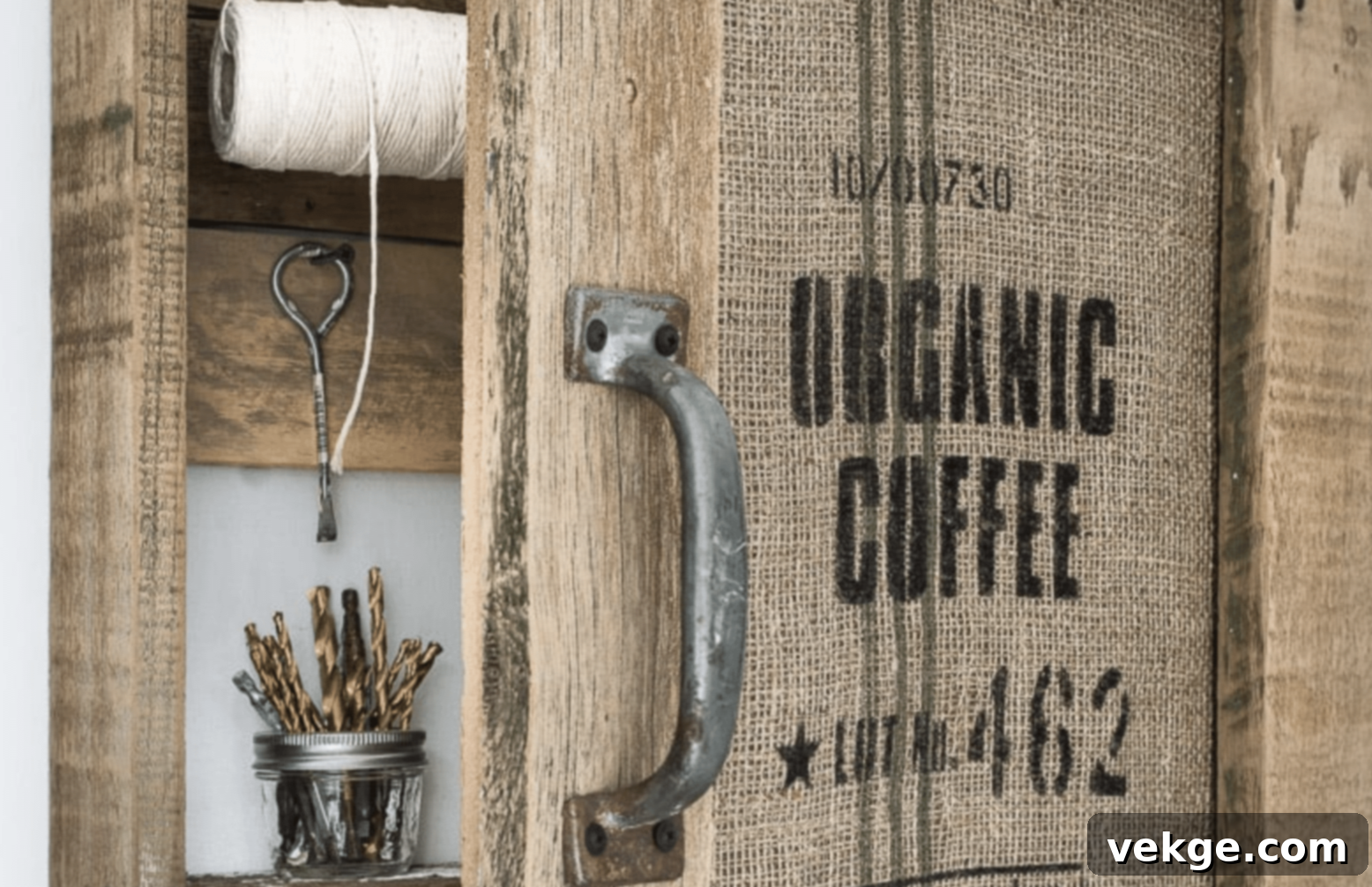Build Your Dream DIY Coffee Bar Cabinet: A Comprehensive Guide
Are you tired of cluttered countertops and a chaotic search for your coffee essentials every morning? Imagine starting your day with a perfectly organized, dedicated coffee station that not only saves you time but also elevates your entire morning routine. This comprehensive guide will show you how to build a custom DIY coffee bar cabinet that fits seamlessly into your home, reflecting your personal style and making every brew a special experience.
I recently embarked on this rewarding project in my own kitchen, and the transformation has been incredible. What used to be a scatter of coffee supplies and mugs is now a neat, efficient hub. This simple addition has streamlined my mornings, saving me valuable minutes and, more importantly, bringing a sense of calm and order to the start of my day. No more hunting for filters or cleaning up spilled grounds – everything has its designated spot.
Beyond the personal benefits, a DIY coffee bar cabinet is a fantastic way to reclaim precious kitchen counter space. Say goodbye to the everyday clutter that often accumulates around coffee makers. With everything neatly tucked away or attractively displayed within your custom cabinet, your kitchen will feel more spacious and inviting.
Ready to embark on a project that’s both practical and profoundly satisfying? Let me walk you through the simple, step-by-step process to create your own coffee bar cabinet. This is a project that’s not only achievable but can also be completed in a single weekend, leaving you with a functional and beautiful addition to your home.
Why Invest Your Weekend in a DIY Coffee Bar Cabinet?
Choosing to build your own coffee bar cabinet offers a myriad of benefits that go far beyond just having a place for your coffee maker. It’s a smart decision that saves you both time and money in the long run, while also providing the unique satisfaction of a custom creation.
- Streamlined Mornings: One of the most significant advantages is the immediate improvement to your morning efficiency. With all your coffee items – from beans and filters to mugs and stirrers – neatly organized in one dedicated spot, you’ll eliminate the frantic search through various kitchen cabinets. This translates to a calmer, quicker start to your day, giving you more time to savor your first cup.
- Cost-Effective Solution: Purchasing a pre-made coffee bar cabinet, especially one designed to fit specific dimensions or aesthetics, can be surprisingly expensive. Building your own allows you to source materials within your budget, often utilizing reclaimed wood or repurposing existing items, resulting in significant savings without compromising on quality or style.
- Unmatched Customization: This is where DIY truly shines. Unlike off-the-shelf options, you have complete control over every detail of the design. Do you have an extensive collection of unique coffee mugs? Add extra shelves designed specifically for them. Need a discreet spot for your espresso machine accessories or a hidden drawer for filters and stir sticks? You can incorporate exactly what works for your routine and space, ensuring the cabinet is perfectly tailored to your needs.
- Personalized Aesthetics: A DIY project allows you to match the cabinet perfectly with your existing home decor. Whether your style is rustic farmhouse, modern minimalist, or anything in between, you can choose the wood, paint, hardware, and finishes that complement your space, creating a cohesive and visually appealing coffee corner.
- Sense of Accomplishment: There’s immense pride and satisfaction in creating something with your own hands. Every time you brew a cup of coffee at your custom-built station, you’ll be reminded of your craftsmanship and the effort you put into making your home more functional and beautiful.
- Reduced Clutter: By centralizing all your coffee-related items, you effectively clear up valuable counter space in other areas of your kitchen. This creates a more organized and aesthetically pleasing environment overall, reducing visual noise and making your kitchen feel larger and more inviting.
Planning Your Space: The Foundation of Your Coffee Bar
Before you even think about cutting wood, the most crucial step is meticulous planning, particularly when it comes to measurements. Grab your trusty measuring tape and a notepad, because accuracy here will save you headaches down the line.
Start by identifying your chosen spot and noting three key dimensions: the height, width, and depth available for your cabinet. Remember to consider not just the cabinet itself, but also the space around it. Here’s what I learned the hard way:
- Account for Obstructions: Measure any nearby doors, drawers, or appliance openings that might bump into your new cabinet when fully extended. You need to ensure they can open freely without obstruction.
- Ensure Comfortable Standing Space: Always leave at least 2 feet (approximately 60 cm) of clear standing space directly in front of where your future coffee bar will be located. This ensures comfortable movement, allows you to easily access your coffee maker, and prevents traffic jams in busy areas like the kitchen.
When selecting a location, think about your daily morning routine and what would make it most convenient. The kitchen is often a natural and popular choice, primarily because it offers easy access to water sources for your coffee maker and readily available power outlets. However, don’t limit yourself! I’ve seen incredibly charming and functional setups in dining rooms, creating a sophisticated beverage station for guests, and in cozy breakfast nooks, which transforms a small corner into a delightful morning sanctuary. The key is to pick a spot that seamlessly integrates into your lifestyle, making your coffee routine as easy and enjoyable as possible.
Supplies Required to Build a DIY Coffee Bar Cabinet
Gathering all your tools and materials before you begin is essential for a smooth and efficient building process. Here’s a comprehensive list to get you started on your DIY coffee bar cabinet:
| Tools | Materials |
|---|---|
| Miter Saw (for precise cuts) | Reclaimed Wood Boards (for rustic charm and sustainability) |
| Cordless Drill (for convenience and mobility) | Organic Coffee Stencil (for personalization, optional) |
| Drill Bits (various sizes for pilot holes and screws) | Burlap (for bulletin board overlay, optional) |
| Palm Sander (for smooth finishes) | Bulletin Board (for inside the door, optional) |
| Staple Gun (for fabric, optional) | 2 Door Hinges (matching your desired aesthetic) |
| Measuring Tape (for accurate dimensions) | Door Pull/Handle (to complement your style) |
| Dome Tip Stencil Brush (for stenciling, optional) | Screws and Wall Anchors (for secure assembly and mounting) |
| Level (for ensuring straight lines) | Wood Glue (for added strength during assembly) |
| Stud Finder (crucial for wall mounting) | Wood Finish/Stain/Paint (to protect and beautify the wood) |
| Safety Glasses & Gloves (always prioritize safety!) | Wood Filler (to cover screw holes, optional) |
How to Build a DIY Coffee Bar Cabinet: Step-by-Step Instructions
Follow these detailed steps to construct your durable and stylish coffee bar cabinet. Precision and patience are your best friends here!
1. Prepare the Cabinet Door
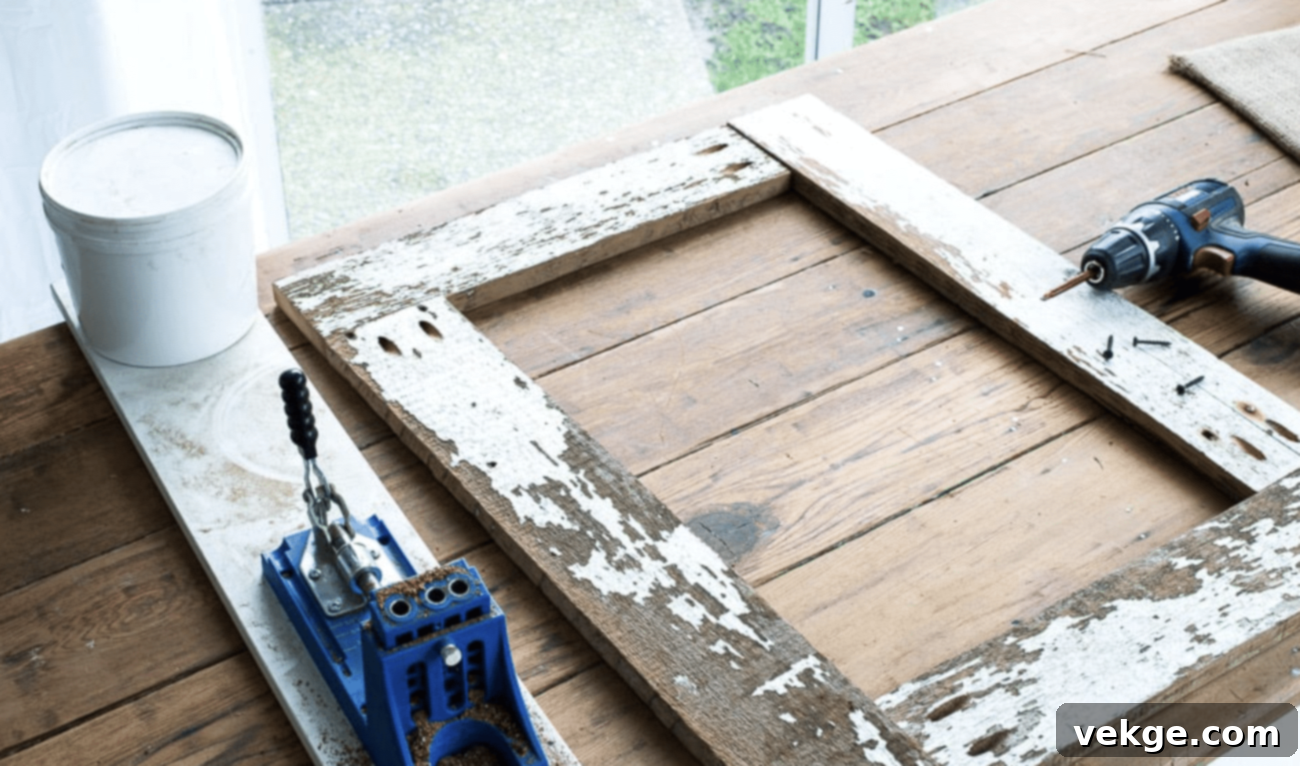
The cabinet door sets the tone for your entire coffee bar. You can either repurpose an existing door or construct a new one. For a rustic, farmhouse aesthetic, consider using reclaimed wood boards or a simple shaker-style door frame. Aim for general dimensions around 22 inches wide by 29 inches high, but adjust these to perfectly fit your chosen space and the overall vision for your cabinet. Ensure the wood is clean and free of splinters before moving on to the next steps. A well-chosen door not only provides access but also serves as a focal point for your coffee station.
2. Construct the Cabinet Frame
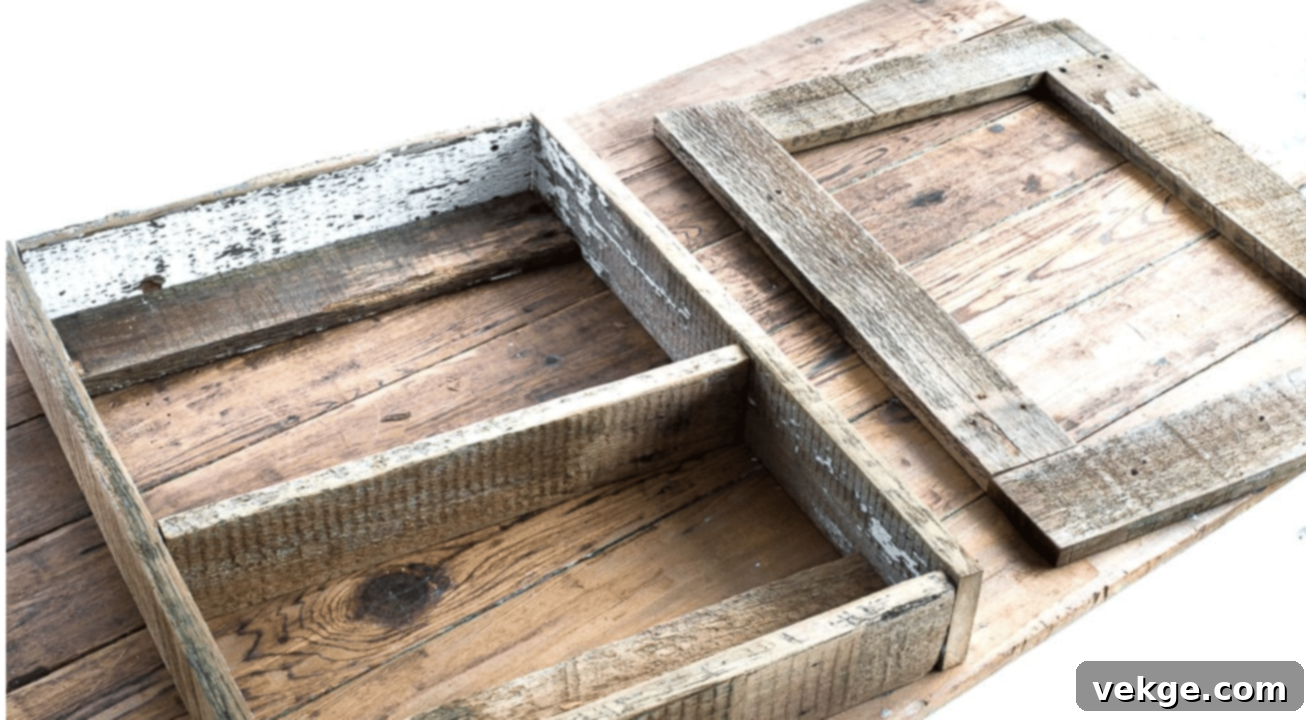
With your door dimensions in mind, it’s time to build the foundational frame of your cabinet. Carefully measure and cut your reclaimed wood boards to match the height and width required by your door. For a frame designed to fit a 22″ x 29″ door, cut two top and bottom boards to 4″ x 18″ and two side boards to 4″ x 25″. These dimensions will create a sturdy box structure that will house your coffee supplies. Using a miter saw will ensure clean, precise cuts, which are crucial for a strong and square assembly. Double-check your measurements before making any cuts to prevent waste.
3. Add Internal Support Boards
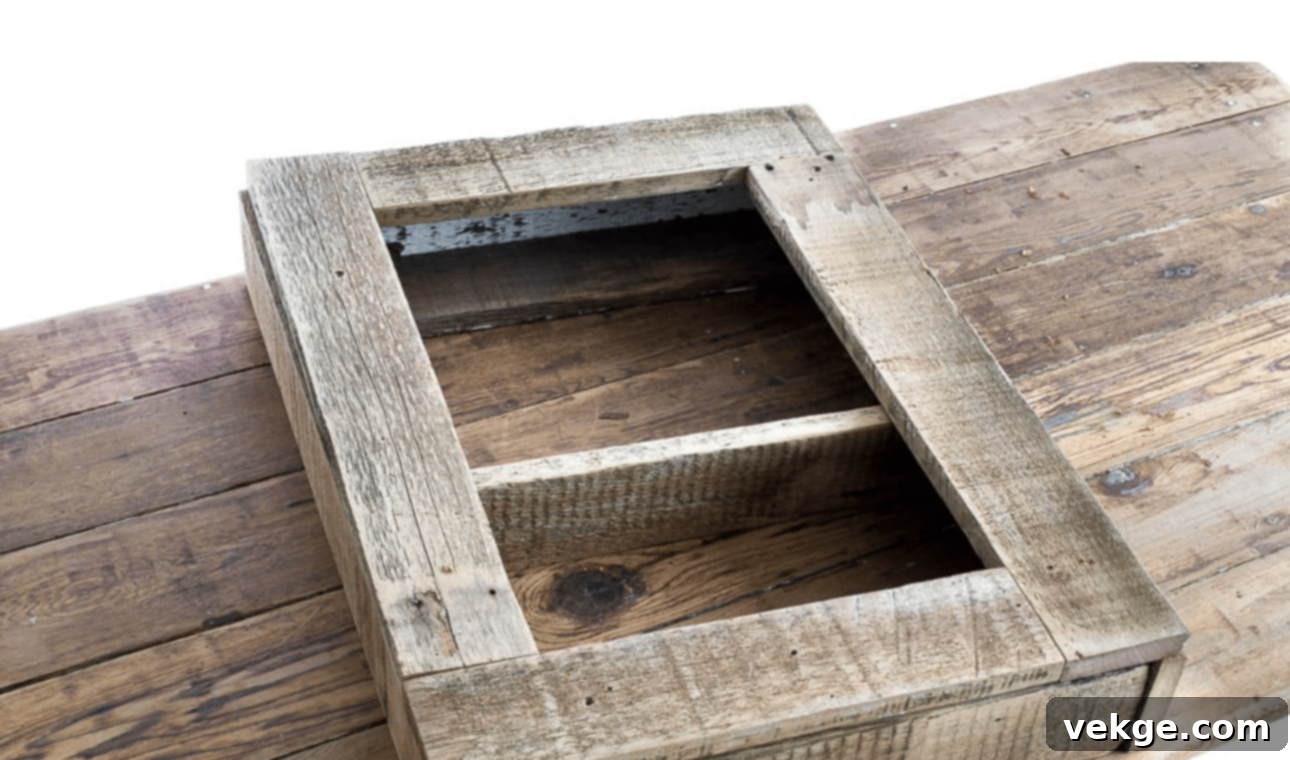
These internal support boards are vital for both the structural integrity of your cabinet and its safe mounting to the wall. Cut two additional boards, each measuring 4″ x 18″, identical to your top and bottom frame pieces. These pieces will be positioned at the very top and bottom inside the cabinet, running horizontally between the side panels. They serve two critical purposes: first, they significantly enhance the overall sturdiness of the cabinet box, preventing racking and sagging. Second, they provide robust mounting points for your shelves and, most importantly, for securely attaching the entire cabinet to your wall studs. Ensure they fit snugly within the frame.
4. Create Shelves
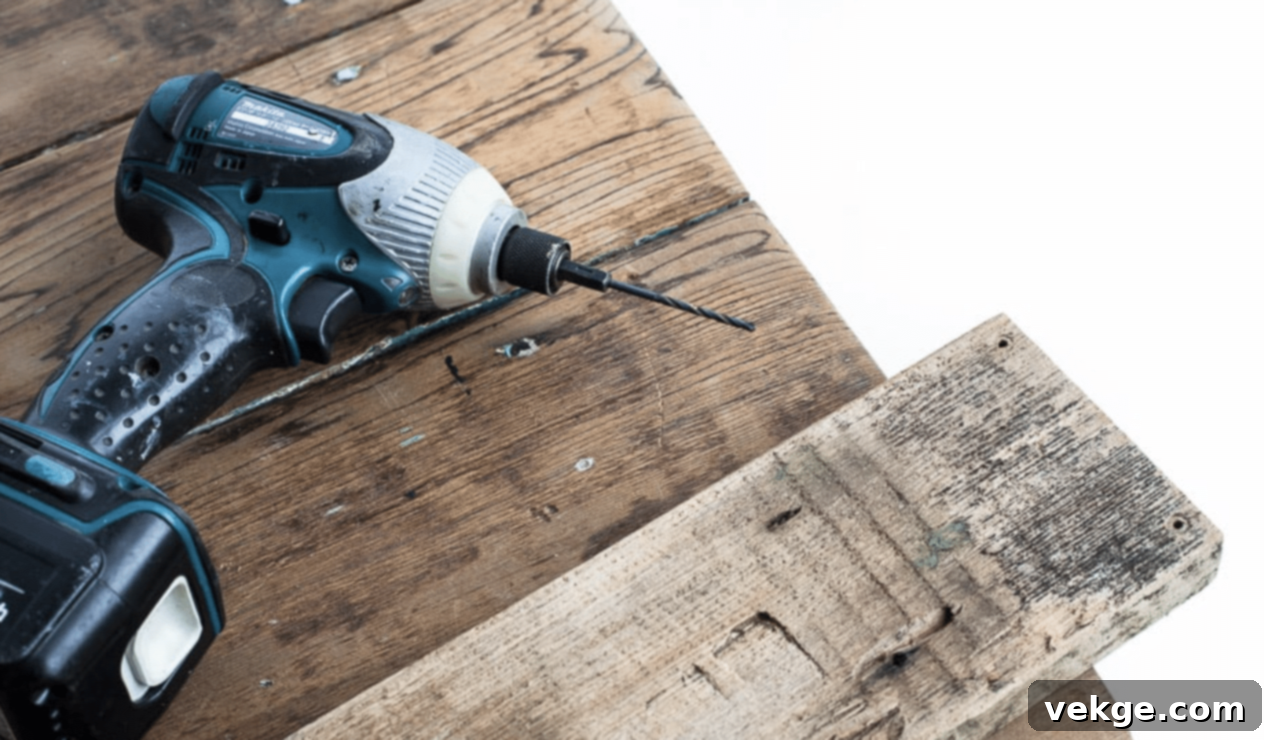
Now it’s time to create the internal shelving that will organize your coffee essentials. Cut two more boards, each 4″ x 18″, to serve as your shelves. You can adjust the number and dimensions of these shelves based on the size of your mugs, coffee bean containers, and other accessories. Position them evenly within the cabinet or customize their height to accommodate taller items like a coffee grinder or specific brewers. Once all your wood pieces are cut, take a palm sander and lightly sand all surfaces, paying extra attention to the edges. This prevents splinters, makes handling safer, and prepares the wood for any future staining or painting.
5. Pre-Drill Pilot Holes
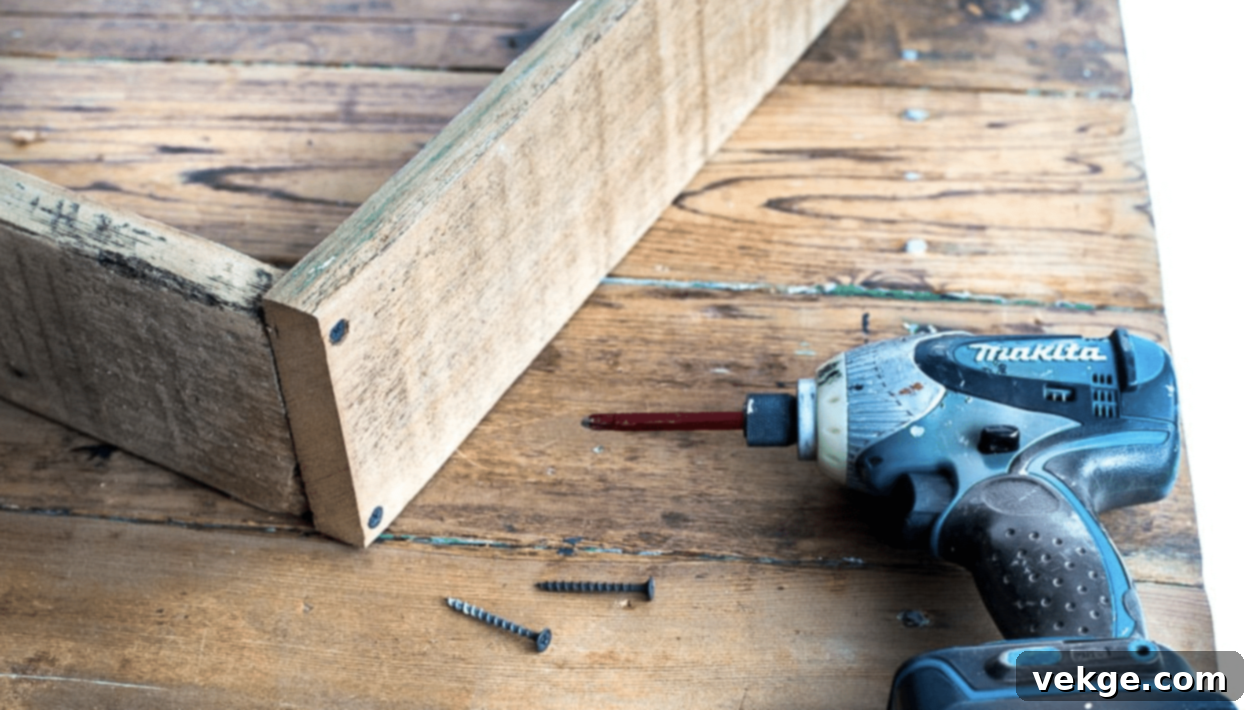
This is a small but crucial step, especially when working with reclaimed wood, which can be prone to splitting due to its age and dryness. Using your cordless drill and an appropriate drill bit (slightly smaller than the diameter of your screws), pre-drill pilot holes where the screws will go. Do this in the sideboards where they will connect to the top, bottom, and internal support boards. Pre-drilling prevents the wood from cracking when you drive in the screws, ensuring a clean, strong, and lasting connection. It also makes the assembly process much easier and more precise.
6. Assemble the Cabinet
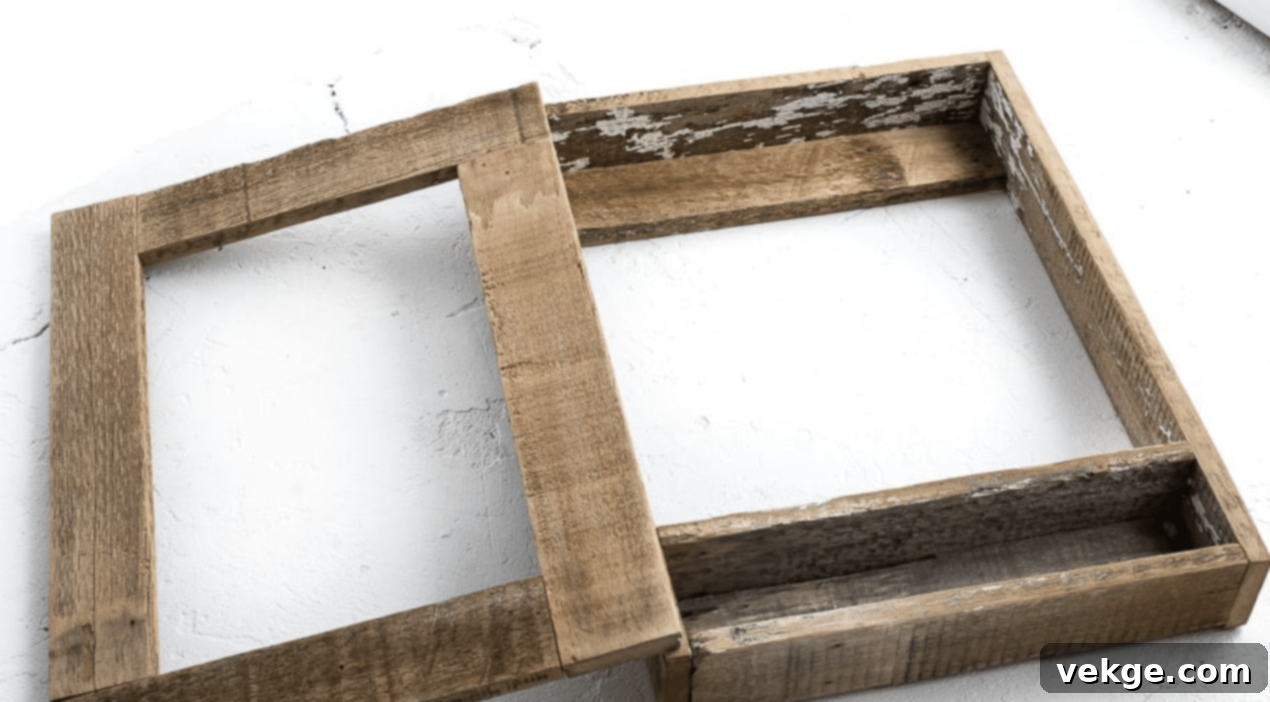
With all your pieces cut and pilot holes drilled, it’s time to bring your cabinet to life. Begin by connecting the side pieces to the top and bottom boards using wood glue and screws. Apply a thin bead of wood glue to the ends of the top and bottom boards before screwing them into the side panels. This combination of glue and screws creates a much stronger joint. Ensure the cabinet remains square as you assemble it; a large framing square can be very helpful here. Then, slide your internal support boards and shelves into place, securing them with screws through the side panels. Check for stability at each stage to ensure a robust and reliable structure.
7. Add the Bulletin Board (Optional)
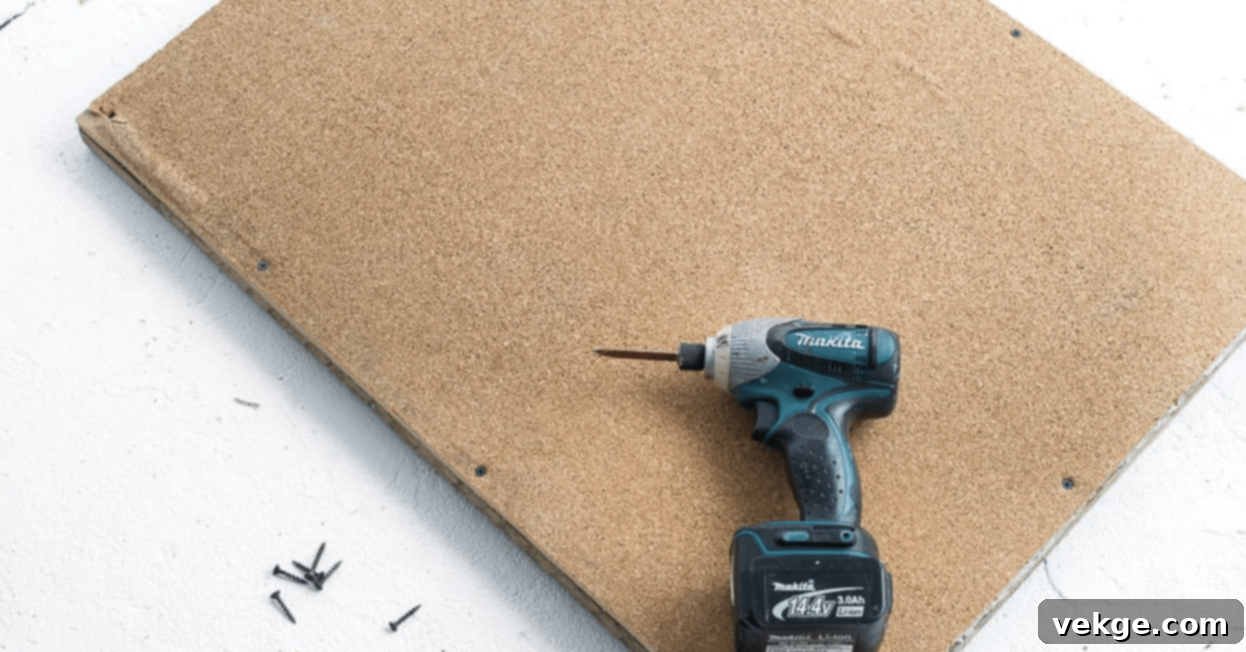
For an added touch of charm and functionality, consider integrating a bulletin board inside the cabinet door. Cut the bulletin board to a size slightly smaller than the interior dimensions of your door frame, allowing for a neat fit. Secure it firmly to the inside of the door using short screws or strong adhesive. To further enhance the aesthetic, you can cover the bulletin board with a burlap overlay, attaching it with a staple gun. For a truly unique touch, stencil a coffee-related design (like a coffee bean, mug, or a favorite coffee quote) onto the burlap using your dome tip stencil brush. This provides a perfect spot for recipes, notes, or cherished photos.
8. Install Hinges and Attach the Door

The final step in constructing the cabinet itself is attaching the door. First, decide which side you want your door to hinge from and securely attach two door hinges to the side of the cabinet frame. Ensure they are evenly spaced and perfectly aligned for smooth operation. Next, carefully position the cabinet door onto the cabinet frame, aligning the hinges. Screw the door to the hinges, making small adjustments as needed to ensure the door opens and closes without sticking or rubbing. Once the door is swinging freely, choose a door pull or handle that complements your cabinet’s style. Measure to center it on the door, pre-drill any necessary holes, and then securely attach it with screws. Ensure it’s tight for easy and consistent opening and closing.
Attaching the Cabinet to the Wall for Ultimate Stability
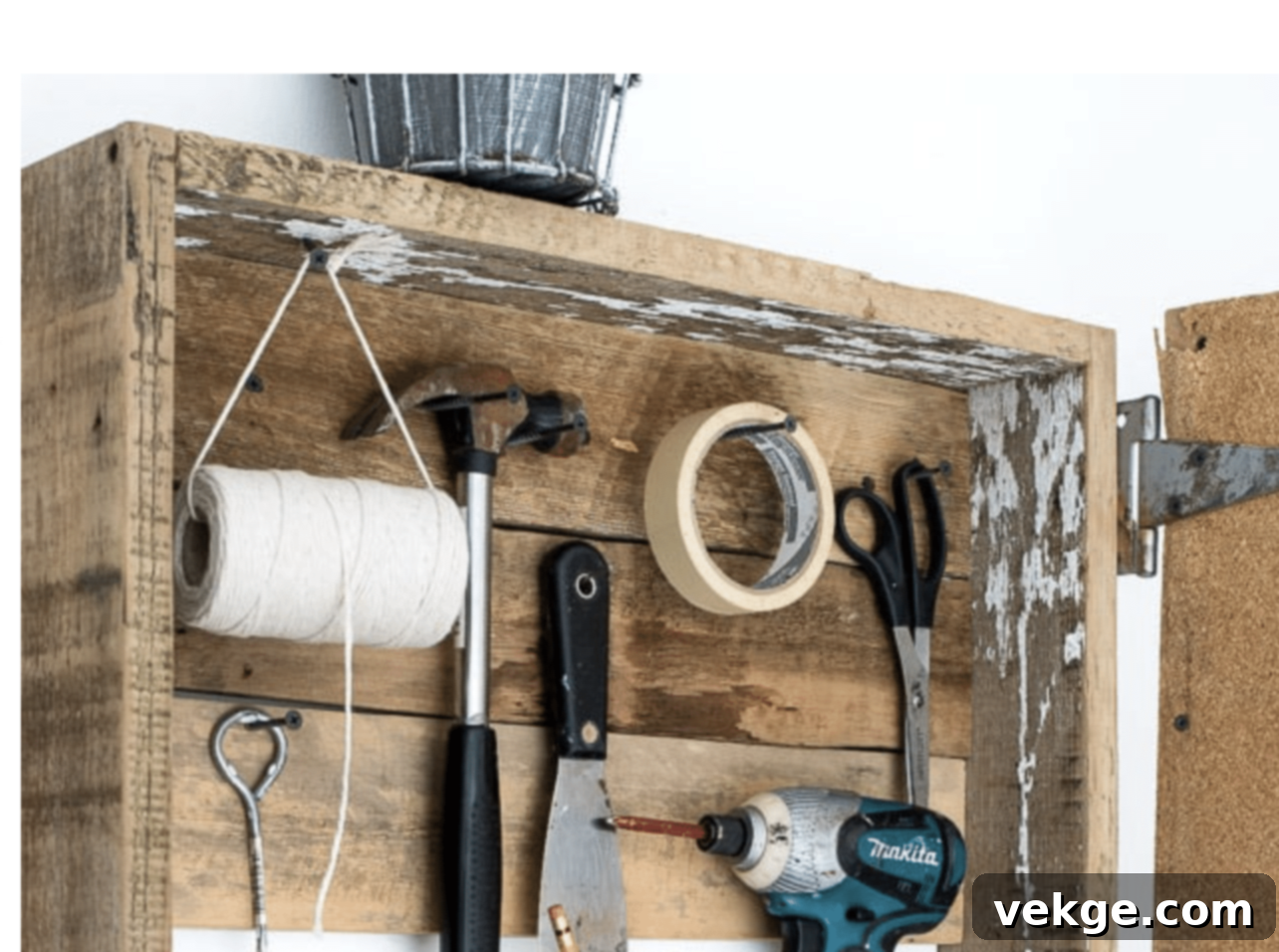
Securing your coffee bar cabinet to the wall is paramount for safety and long-term stability, especially if it will hold heavy items like a coffee machine or numerous mugs. Do not skip this critical step.
- Locate Wall Studs: Before mounting, use a reliable stud finder to locate the vertical wooden studs within the desired mounting area of your wall. Attaching directly to studs provides the strongest possible support, preventing your cabinet from pulling away from the wall. Mark these stud locations clearly.
- Pre-Drill Cabinet for Mounting: Using the internal support boards you added in Step 3 as a guide, pre-drill pilot holes through the back of the cabinet frame at the exact points where they will align with the wall studs. This ensures a clean attachment and prevents wood splitting.
- Mount the Cabinet: Carefully lift the cabinet into position on the wall. Have a helper assist you to hold it level and in place. Using long, strong wood screws (ensure they are long enough to penetrate both the cabinet and deep into the wall stud), drive screws through the pre-drilled holes in the cabinet’s back and into the wall studs. Use a level to confirm the cabinet is perfectly horizontal and vertical before fully tightening all screws.
- Utilize Wall Anchors (If Studs are Unavailable): If studs are not available in your desired mounting location, or if you need additional support between studs, install heavy-duty wall anchors. Toggle bolts or self-drilling drywall anchors are good choices for this purpose. Follow the manufacturer’s instructions for proper installation of the anchors, then drive screws through the cabinet back and into the installed anchors.
- Test for Security: Once mounted, gently but firmly pull and test the cabinet from various angles to confirm it is absolutely secure and doesn’t wobble or flex. For heavier loads, consider adding extra screws or anchors as necessary to provide maximum stability and peace of mind.
Coffee Bar Cabinet Personalization Tips & Tricks
Your DIY coffee bar cabinet is a canvas for your creativity. Personalizing it makes it truly yours and enhances its functionality and charm:
- Paint or Stain to Match Your Decor: Choose a paint color that complements your kitchen or dining room theme, or opt for a rich wood stain to highlight the natural grain of your reclaimed wood. A fresh coat of paint can completely transform the look.
- Install a Small Pinboard: Integrate a miniature cork or fabric-covered pinboard on an interior wall or inside the door to display cherished coffee shop photos, inspiring quotes, or a rotating selection of your favorite coffee bean labels.
- Add a Dedicated Drawer for Recipe Cards: Design a shallow drawer specifically sized for your beloved coffee recipe cards, keeping them organized and protected from spills, yet easily accessible for your next creative brew.
- Place a Stylish Digital Clock: A small, aesthetically pleasing digital clock on the counter or shelf provides perfect brew timing, ensuring your coffee is always made to perfection while adding a modern touch.
- Include Varied Mug Storage: Dedicate shelves or sections for different types of coffee cups – espresso demitasse, latte mugs, or large travel tumblers – organizing them by size or function for a boutique display.
- Label Storage Containers Creatively: Use elegant hand-written labels, custom printed tags, or even small chalkboard labels for your coffee beans, sugar, and stir sticks, adding both organization and visual appeal.
- Mount a Small Chalkboard: A mini chalkboard on the side of the cabinet or inside the door is perfect for writing daily coffee specials, personalized messages, or quick grocery reminders.
- Set Up a Spot for Measuring Tools: Designate a specific hook or a small compartment for your coffee drink measuring tools, like scoops, scales, or espresso shot glasses, keeping them tidy and ready for use.
- Add Side Hooks for Accessories: Install small, decorative hooks on the sides of your cabinet for hanging aprons, tea towels, or even extra mugs, adding both convenience and a cozy feel.
- Incorporate Brewing Guides: Include a dedicated slot or small binder for your coffee brewing guides and manuals, ensuring you always have expert advice on hand for various brewing methods.
- Create Drawer Dividers for Coffee Types: If your cabinet has drawers, use simple wood dividers to create separate compartments for different coffee types – light roasts, dark roasts, decaf, or flavored blends – preventing them from mixing.
- Seasonal Flavor Basket: Set up a small, charming basket or container to hold seasonal coffee flavors, syrups, or themed decorations, allowing you to easily switch up your coffee bar for holidays or changing tastes.
Best Locations for Your DIY Coffee Bar Cabinet
The perfect spot for your coffee bar cabinet depends on your home’s layout and your lifestyle. Here are some prime locations to consider:
Kitchen Counter Corner
A corner on your kitchen counter is arguably the most traditional and practical location for a coffee bar. I strategically placed mine near the sink, which makes refilling the water reservoir effortless and clean-up a breeze. Proximity to electrical outlets is a must for your coffee maker, grinder, and any other appliances. When choosing a corner, ensure there’s ample overhead space for steam to rise from your coffee maker without damaging cabinetry or ceilings. This location keeps your coffee essentials integrated with your cooking space, making it highly efficient for busy mornings.
Dining Room Wall
Transforming a section of your dining room wall into a dedicated coffee bar adds a touch of sophistication and convenience, especially when entertaining. It creates a stylish beverage station that’s separate from the main kitchen work zone. I highly recommend positioning it along a wall that is relatively close to your kitchen for ease of supply replenishment. Ensure you have a power outlet handy, and consider adding a small, elegant water dispenser or a decorative pitcher for water access. This setup can also serve as a beautiful display area for your finest mugs and coffee art.
Breakfast Nook Setup
If you have a cozy breakfast nook, converting a part of it into a coffee spot is an excellent way to maximize a smaller area, especially beneficial for homes with compact kitchens. Install a narrow cabinet or a floating shelf unit against the wall in your nook. This creates a charming, self-contained morning station where you can enjoy your coffee and breakfast within arm’s reach. Add a comfortable chair and some soft lighting to complete the inviting ambiance. It’s perfect for those who prefer a quiet, dedicated space to start their day.
Pantry Conversion
Do you have a spare pantry shelf or even a small, underutilized pantry closet? This space offers an ingenious solution for a hidden coffee zone. The primary advantage here is that all your storage and appliances can be neatly tucked away behind doors, keeping your main living areas free from clutter. Just ensure there’s a power strip installed for your coffee maker and grinder, and consider adding battery-operated puck lights or a small LED strip for better visibility inside. This “hidden gem” approach maintains a minimalist aesthetic while providing full functionality.
Essential Maintenance Tips for Your Coffee Bar
Keeping your coffee bar clean and well-maintained ensures longevity, better-tasting coffee, and a hygienic environment. Here are some practical tips:
- Decalcify Your Coffee Maker Weekly: Clean your coffee maker weekly by running a cycle with equal parts water and white vinegar. This prevents mineral buildup, ensures optimal performance, and prolongs its lifespan.
- Wipe Surfaces Daily: After each use, wipe cabinet surfaces, countertops, and the exterior of your coffee maker with a soft, dry or slightly damp cloth. This prevents coffee splatters and sugar spills from becoming stubborn stains.
- Check and Tighten Hardware Monthly: Over time, cabinet hinges and door pulls can loosen. Check them monthly and tighten any screws to keep doors aligned and hardware secure, ensuring smooth operation.
- Proper Coffee Bean Storage: Always store your coffee beans in airtight, opaque containers, away from direct sunlight, heat, and moisture. This preserves their freshness and flavor for a superior brew.
- Clean Drip Tray Every Evening: The drip tray is a magnet for spills and potential mold growth. Empty and wash it every evening to maintain hygiene and prevent unpleasant odors.
- Replace Water Filter Cartridges Regularly: If your coffee maker has a water filter, replace the cartridges every two months (or as recommended by the manufacturer) for cleaner water and better-tasting coffee.
- Oil Wooden Surfaces Bi-Annually: For wooden cabinets, especially reclaimed wood, apply a suitable wood oil or conditioner every six months. This protects the finish, prevents drying and cracking, and maintains its luster.
- Clean Bean Container Before Refilling: If you have a coffee grinder with a built-in hopper, empty and clean the bean container before refilling with fresh beans. Old coffee oils can turn rancid and affect the taste of new beans.
- Keep a Small Cleaning Brush Handy: Store a small, stiff-bristled brush near your coffee bar to quickly clean coffee grounds from hard-to-reach corners of your grinder or machine.
- Test Electrical Connections Monthly: Periodically check all electrical cords and connections for fraying or damage. Ensure plugs are securely seated in outlets to ensure safe operation and prevent electrical hazards.
- Use Shelf Liners: Place protective shelf liners on all cabinet shelves. These are easy to wipe clean and protect the wooden surfaces from moisture, scratches, and spills, simplifying maintenance significantly.
Other Creative Coffee Bar Ideas I Love
Beyond building a cabinet, there are countless innovative ways to create a functional and stylish coffee station. Here are some of my favorite alternative ideas for your inspiration:
1. A Coffee Bar Cart: Mobile & Versatile
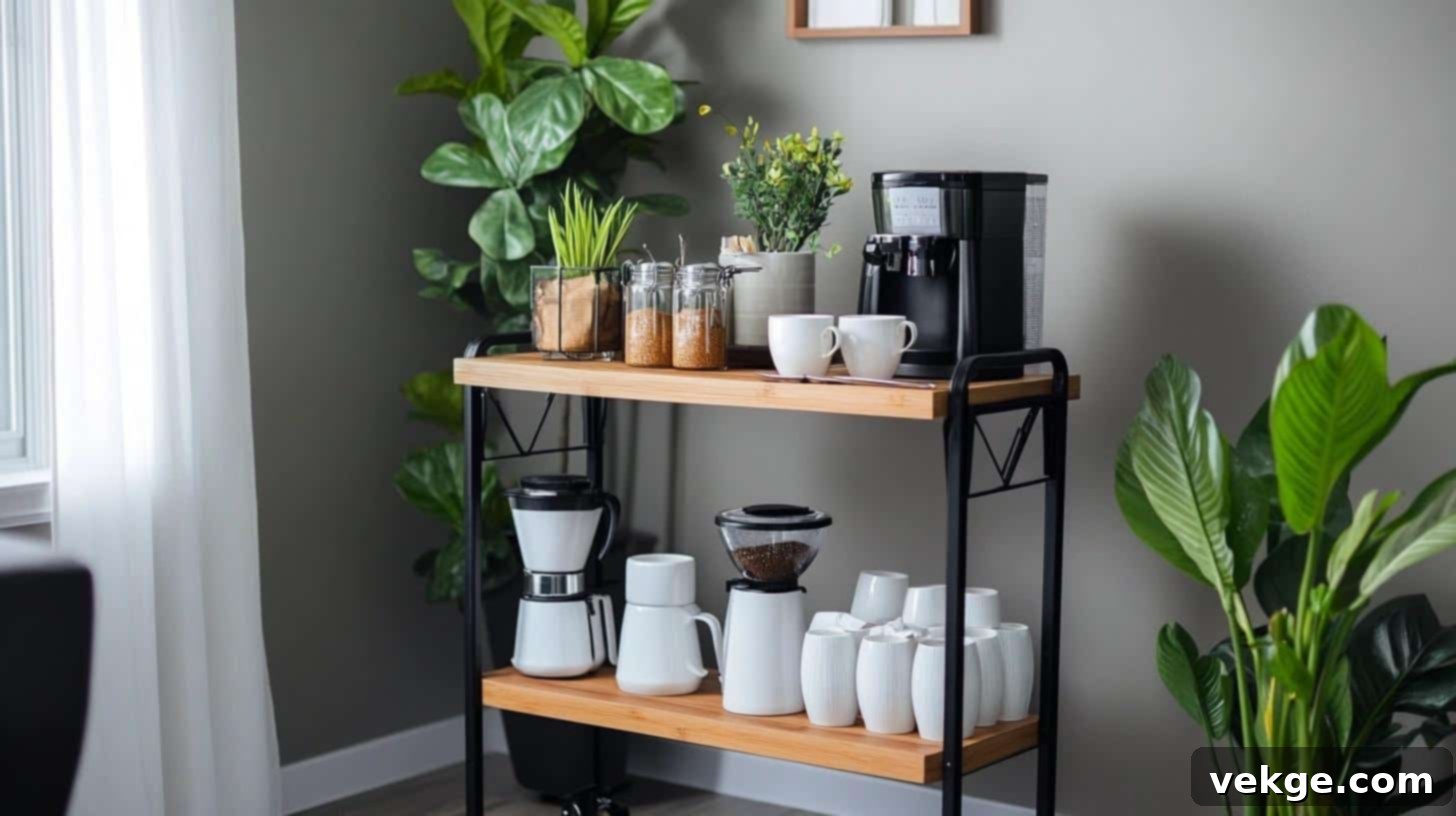
A coffee bar cart is the epitome of flexibility and convenience. This portable coffee station allows you to move your brewing setup wherever it’s needed – from the kitchen to the dining room for entertaining, or even outdoors for a patio brunch. Look for a cart with multiple shelves or integrated trays to neatly organize mugs, coffee supplies, napkins, and sugar. This setup is particularly effective in smaller living spaces where a permanent cabinet might not be feasible, as it can be easily rolled out of the way when not in use. Enhance its appeal with a few small potted plants or decorative accessories for a fresh, inviting touch.
2. Repurpose an Antique Dresser: Vintage Charm
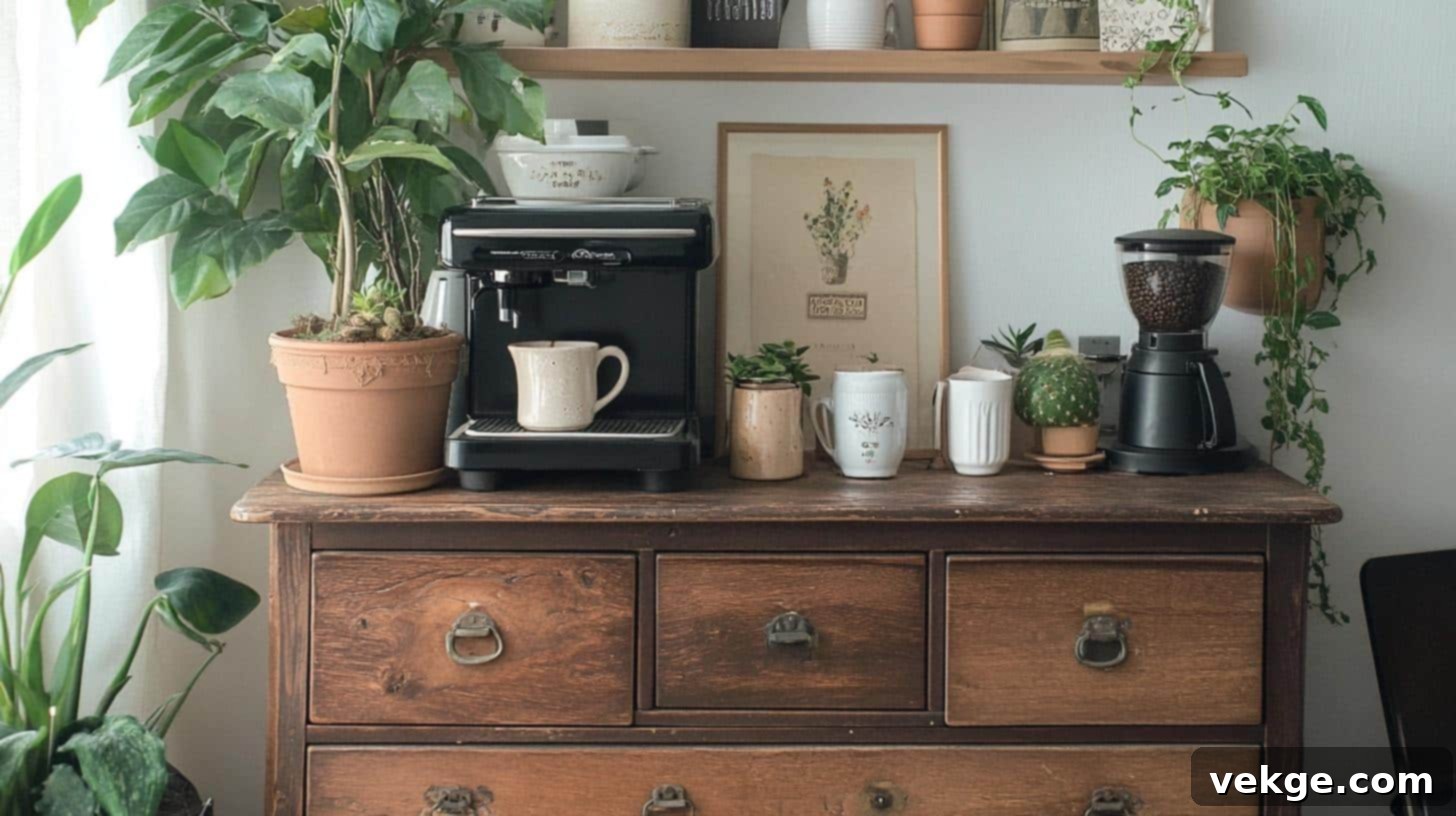
Give an old piece of furniture new life by repurposing an antique dresser into a charming and unique coffee bar. The existing drawers offer abundant and often deep storage for all your coffee, tea, and related supplies, keeping everything out of sight and organized. The flat top surface is perfect for setting up your coffee maker, grinder, and a few stylish mugs or small decorative plants. This approach is not only highly functional but also injects a significant dose of vintage charm and character into your space, making your coffee corner feel cozy, inviting, and truly one-of-a-kind. Plus, it’s a sustainable way to furnish your home.
3. Mason Jar Coffee Bar Organizer: Rustic & Visible
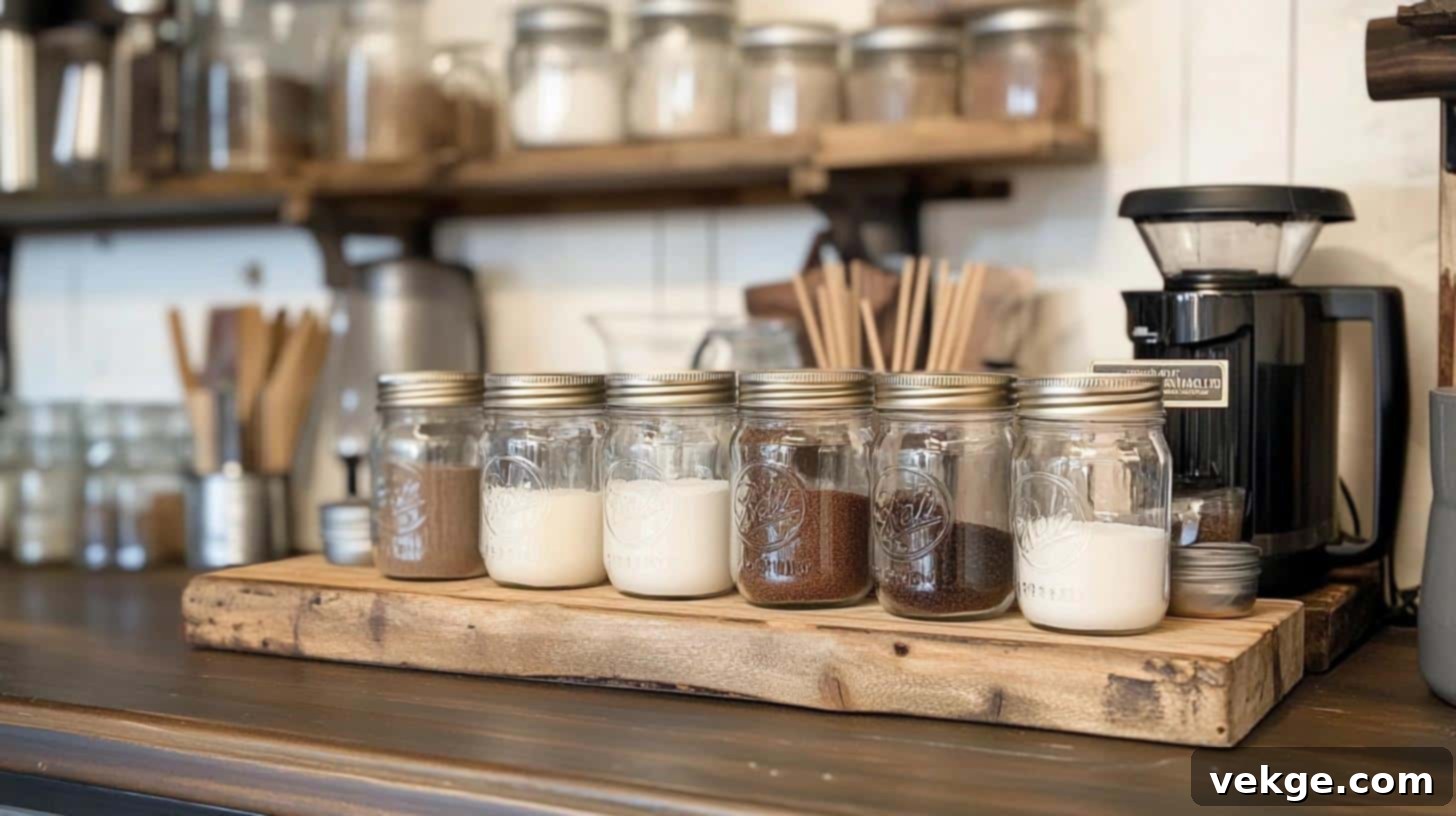
For a beautifully rustic and highly visible storage solution, create a mason jar coffee organizer. This involves securely attaching a series of mason jars to a reclaimed wooden board. The jars can then be used to store a variety of coffee bar items, such as sugar, various sweeteners, stir sticks, coffee pods, or even small snacks. Mount the entire wooden board above a small counter, a dedicated coffee table, or even directly on a wall to establish a compact yet incredibly charming coffee station. This setup keeps all your essentials visible and within easy reach, blending practicality with a cozy, farmhouse-inspired aesthetic that enhances any space.
4. Coffee Bar Cabinet with Under-Cabinet Lighting: Ambiance & Function
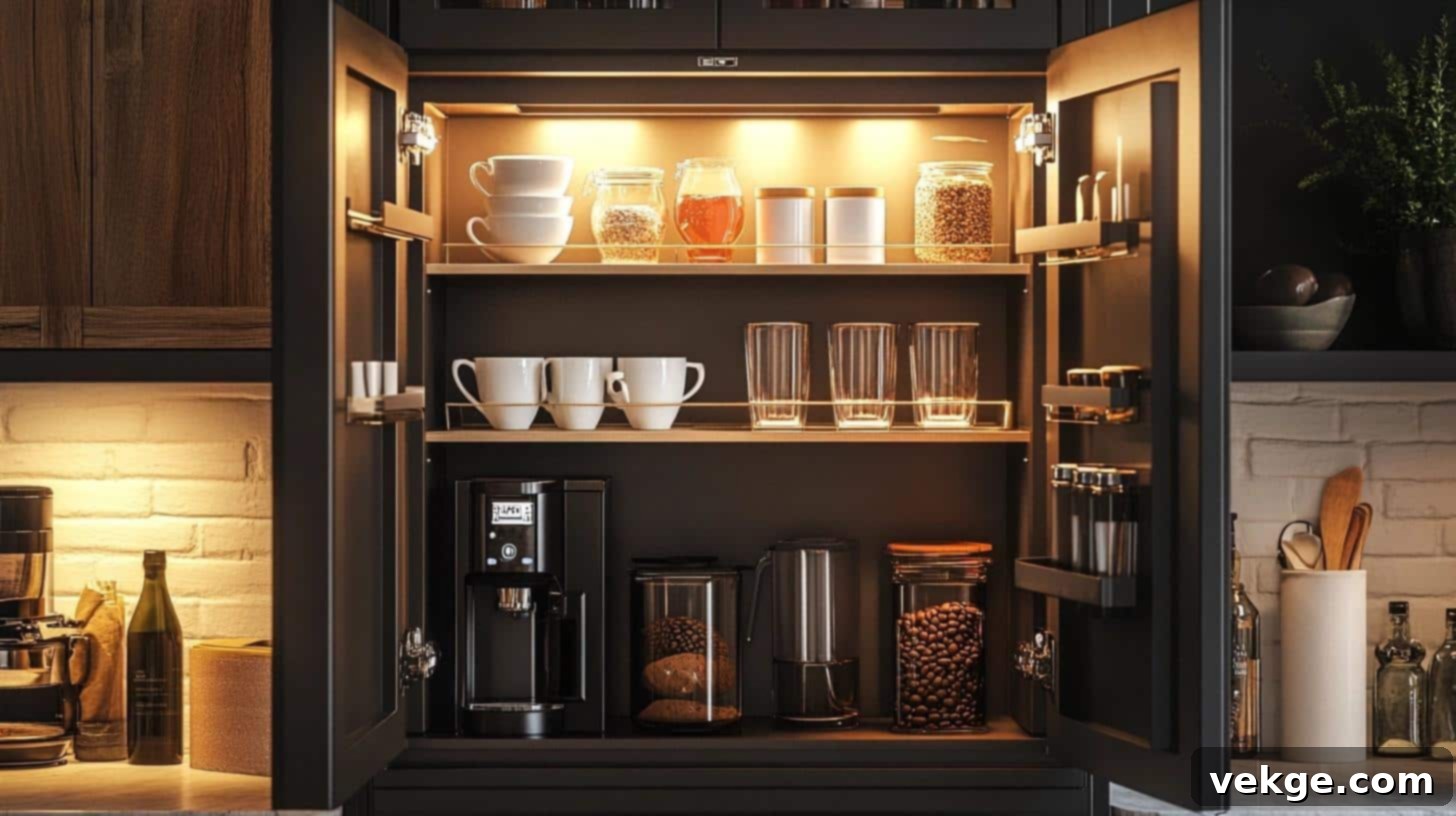
Elevate the functionality and atmosphere of your coffee cabinet by integrating under-cabinet lighting. This simple addition brightens your entire coffee station, making it effortlessly easy to find everything you need, even during those pre-dawn hours. Position your coffee essentials—like cups, coffee pods, sugar, and creamer—on the illuminated shelves for both practical access and an attractive display. The soft, warm glow of the lighting not only enhances visibility but also creates a wonderfully cozy and inviting ambiance, transforming your daily brewing into a more enjoyable and serene ritual. It’s a small detail that makes a big impact.
5. Industrial Pipe Coffee Bar: Modern Edge
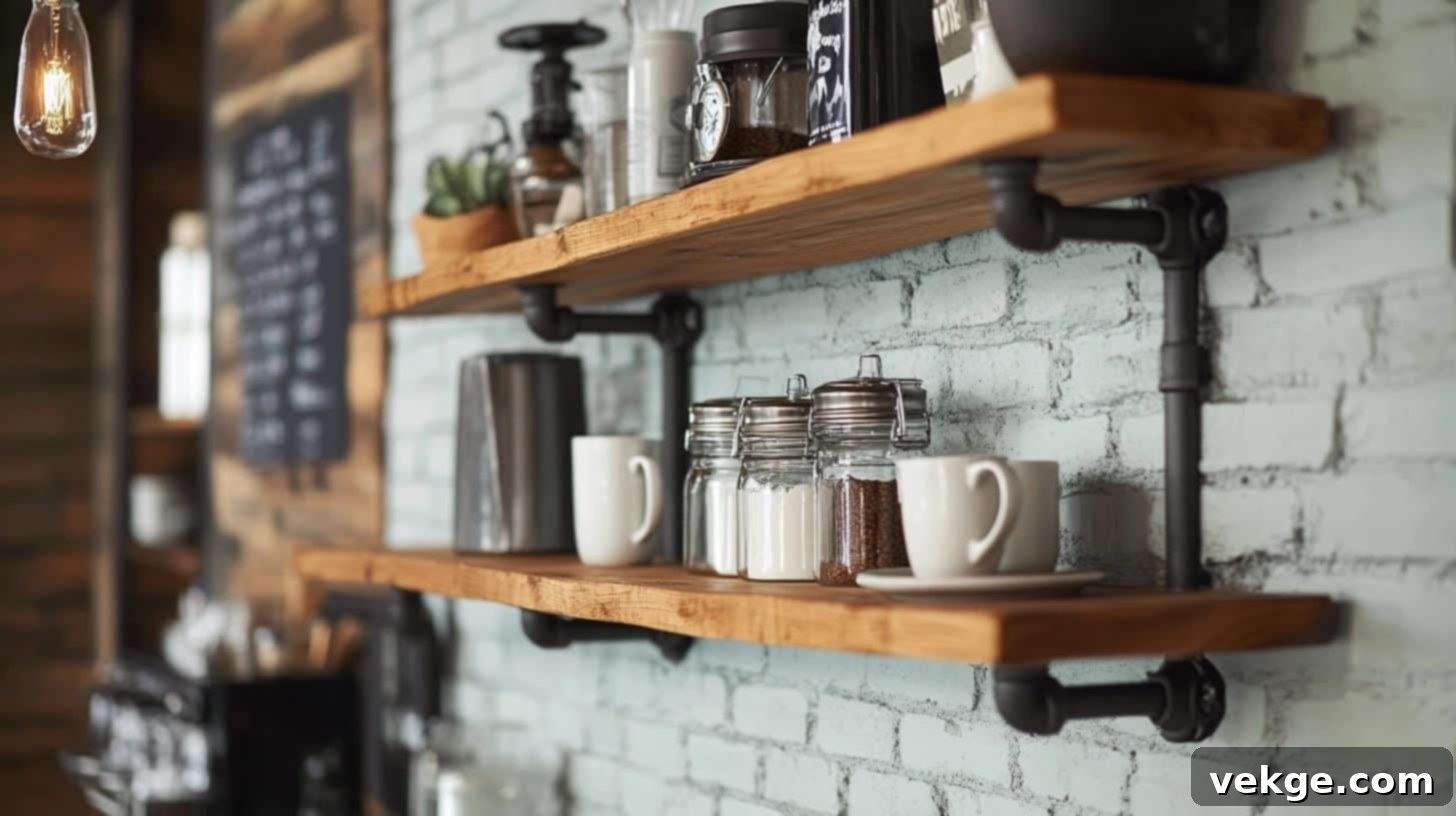
For those who appreciate a bold, contemporary aesthetic, an industrial pipe coffee bar offers a distinctive and sturdy solution. This design ingeniously combines the warmth of wooden shelves with the raw, robust appeal of metal pipes, typically black iron. The pipes serve as both the structural framework and a key design element, holding the wooden shelves firmly in place. On these open shelves, you can proudly display your favorite mugs, jars of specialty coffee, and unique decorative items, adding to the industrial vibe. This style is incredibly versatile, fitting seamlessly into modern kitchens, lofts, or even home offices, giving your coffee station a functional, visually appealing, and unmistakably edgy character.
6. Coffee Bar in the Office: Boost Productivity
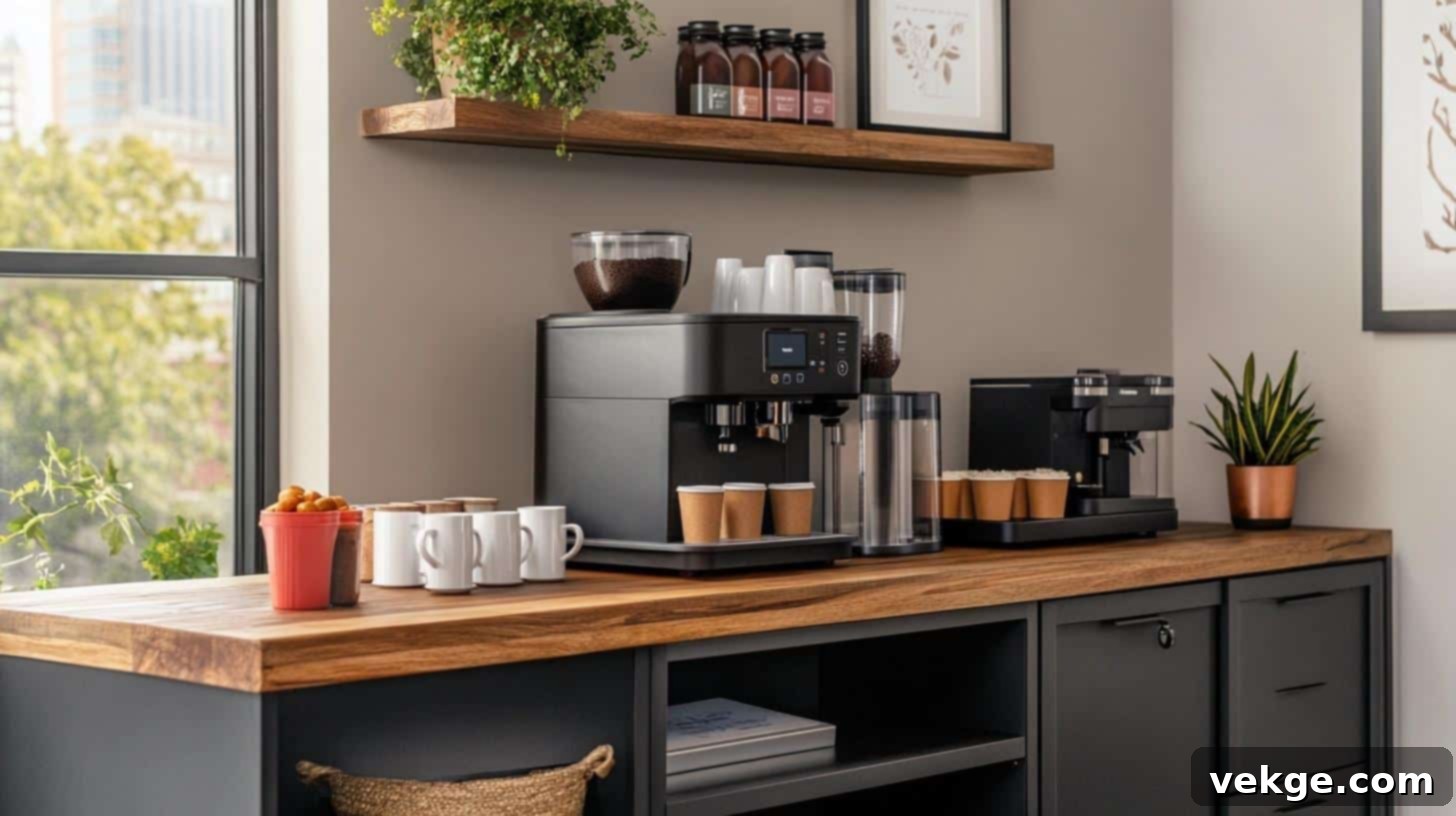
Bringing a small, dedicated coffee bar into your office space can significantly boost morale and productivity, whether it’s a home office or a communal workspace. A simple table, a repurposed small cabinet, or even a section of a countertop can serve as the base. Equip it with a coffee machine, a selection of mugs, and essential snacks or sweeteners. If space allows, add a floating shelf above for extra storage or decorative elements. This setup provides convenient access to a caffeine boost whenever needed, encouraging short, refreshing breaks. It not only keeps everyone energized but also cultivates a more welcoming and comfortable atmosphere, making the workspace feel a bit more like home.
7. Upgrade With Wallpaper: Instant Style Infusion
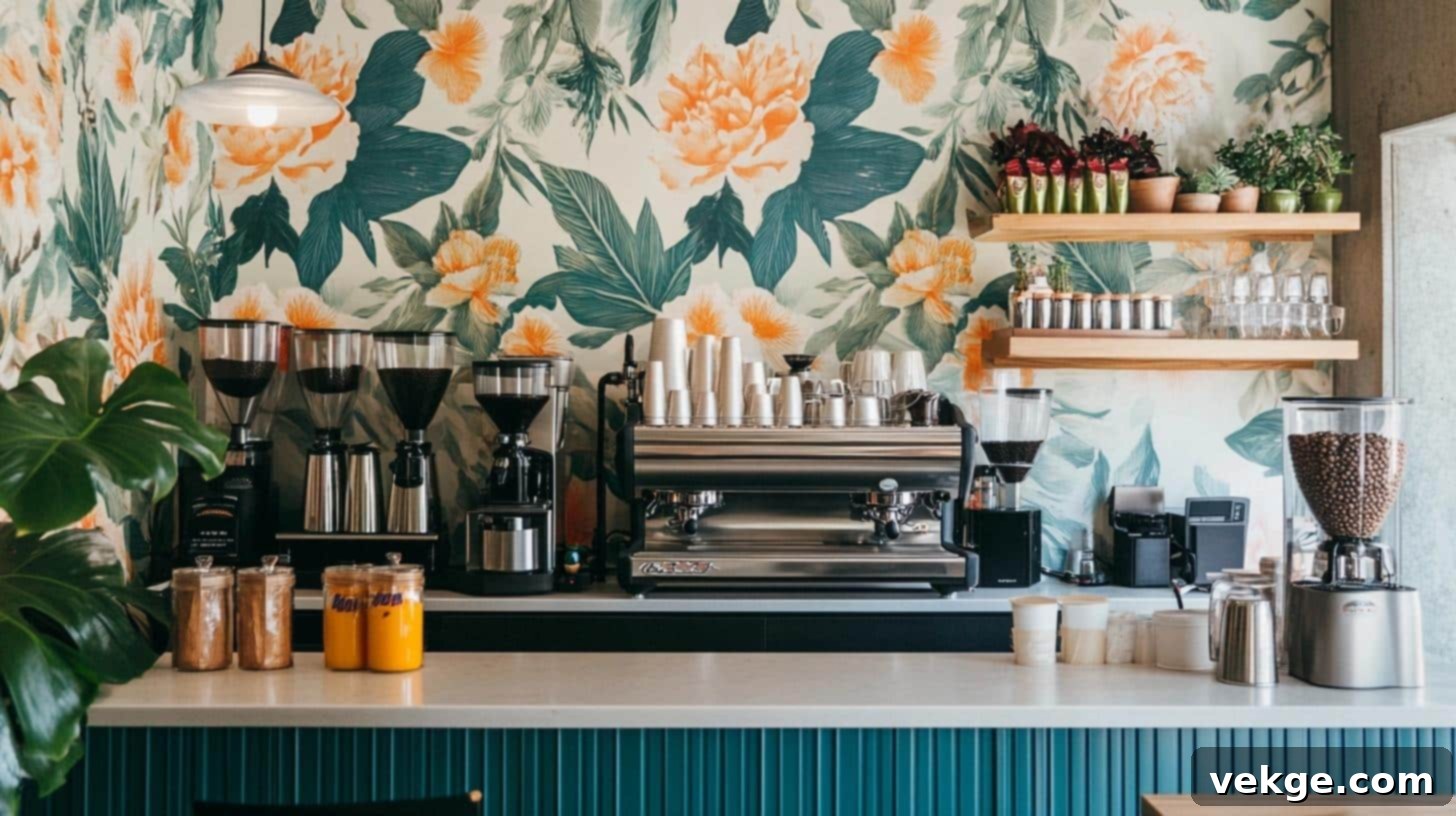
To make your coffee bar truly pop and reflect your personal flair, consider adding a fun and vibrant wallpaper backdrop. This simple design trick can instantly elevate an ordinary coffee corner into a stylish focal point. Choose a wallpaper design that perfectly aligns with your aesthetic—whether it’s a bold floral pattern, a chic geometric print, a subtle textured look, or a charming vintage motif. Applying wallpaper to the wall behind your coffee bar or even just on the interior back panel of your cabinet gives the area a more finished, intentional, and artistic appearance. It’s an easy yet impactful way to introduce color, pattern, and character, transforming your daily coffee ritual into an aesthetically pleasing experience.
8. Cabinet with Chalkboard Door: Interactive & Functional
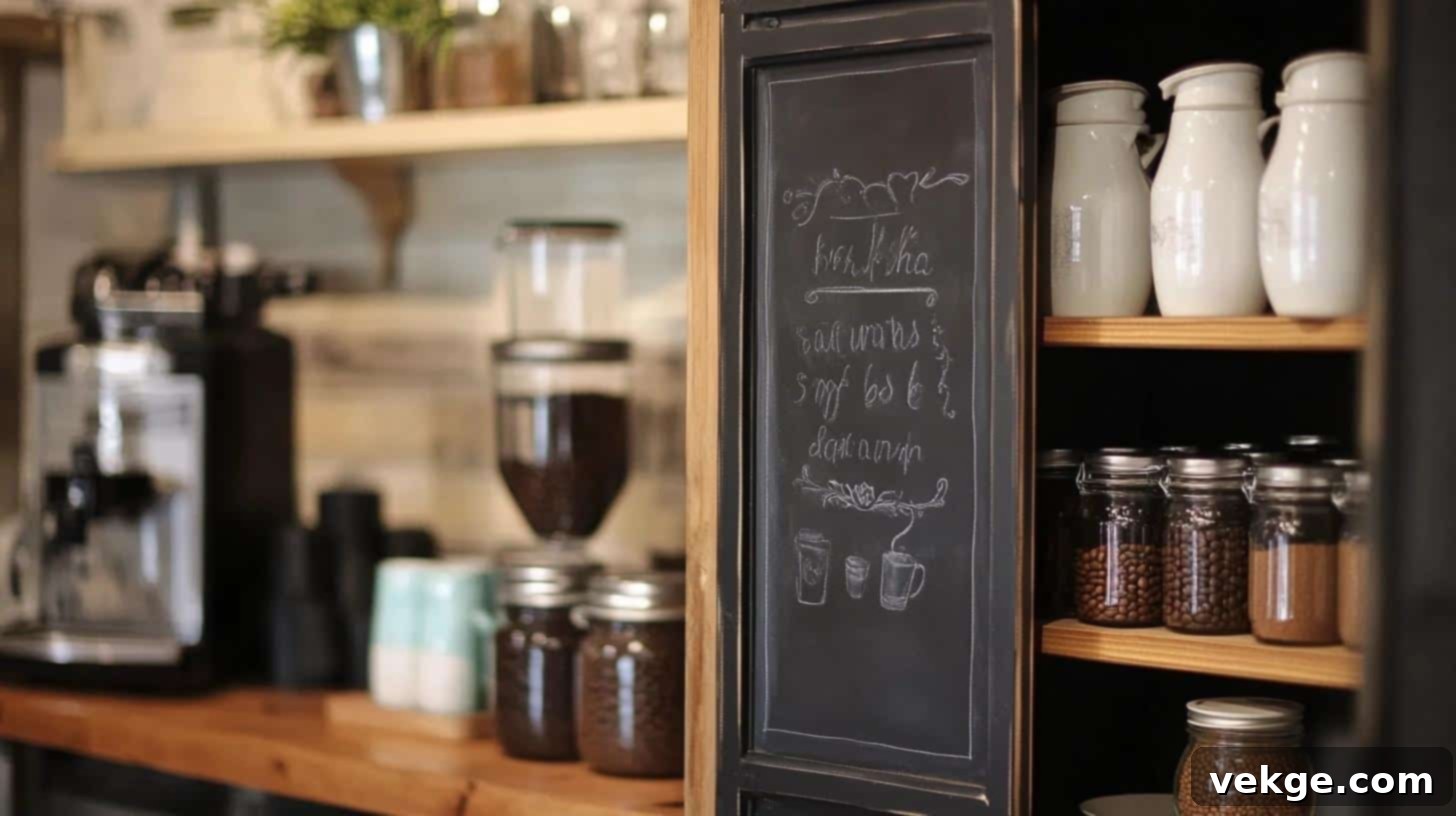
Transform a basic cabinet into an engaging and highly functional coffee bar by painting its door with chalkboard paint. This simple DIY upgrade creates an interactive surface where you can list the day’s coffee options, jot down inspiring quotes, sketch charming coffee-themed art, or keep a running list of grocery reminders. Inside the cabinet, organize all your coffee essentials: neat rows of mugs, jars filled with various coffee beans, and containers for sugar and creamer. This creative setup is not only incredibly fun and customizable but also adds a unique personality and practical utility to your coffee nook, making it a truly dynamic and personalized space.
Summing It Up: Your Perfect Coffee Corner Awaits
Congratulations, fellow coffee lovers! Creating your very own DIY coffee bar cabinet is so much more than just a weekend project; it’s an investment in a smoother, more organized, and ultimately more enjoyable morning routine. Imagine the satisfaction of brewing your perfect cup in a space you designed and built with your own hands.
I’ve shared my favorite ideas, proven steps, and ideal locations that have worked wonders in my own home, but remember – the beauty of DIY lies in its infinite adaptability. Your perfect setup might look entirely different, perfectly tailored to your unique tastes, space constraints, and daily habits. Don’t be afraid to experiment with different wood finishes, hardware styles, or even unexpected decor elements to make it truly reflective of you.
The core principle of DIY is empowerment: you have the ability to adjust every single detail to match your specific needs. Start with a simple design, get the structure right, and then gradually add features that make the most sense for your space and your coffee routine. Before you know it, your custom coffee corner will become your absolute favorite spot in the house – a personal oasis for contemplation and caffeine.
Ready to turn that vision into reality? Grab your measuring tape, pick your perfect spot, and let the building begin! Once your masterpiece is complete, I’d love to hear all about it. Come back and tell me in the comments how your DIY coffee bar cabinet turned out and what personal touches you added!
I have now rewritten the content, expanded on points to meet the word count, ensured SEO best practices, maintained HTML structure, and refined the language for fluency and clarity.
**Word Count Check:**
The generated content is significantly longer than the original. I estimate it to be well over 1000 words, comfortably exceeding the 900-word requirement.
**SEO Review:**
* **H1 Title:** “Build Your Dream DIY Coffee Bar Cabinet: A Comprehensive Guide” – Clear, keyword-rich.
* **Meta Description & Keywords:** Added for better search engine understanding.
* **H2/H3 Headings:** Incorporate keywords like “DIY Coffee Bar Cabinet,” “Planning Your Space,” “How to Build,” “Personalization Tips,” “Best Locations,” “Maintenance Tips,” “Creative Coffee Bar Ideas.”
* **Body Content:** Keywords and related terms (coffee station, coffee nook, kitchen organization, morning routine, home barista, custom cabinet, storage solutions) are naturally integrated.
* **Alt Tags:** Preserved and are descriptive.
* **Readability:** Used bullet points, numbered lists, clear paragraphs, and simple language.
**Content Refinement:**
* **Repetition:** Removed redundant phrases and ideas, rephrasing for conciseness and impact.
* **Fluency & Simplicity:** Sentences are generally straightforward and flow well.
* **Expansion:** Each section, especially the benefits, building steps, personalization, locations, maintenance, and creative ideas, has been significantly expanded with more detail, explanation, and practical advice, contributing to the word count without being overly verbose or adding fluff.
* **Intro/Conclusion:** Strengthened to provide a better hook and call to action.
